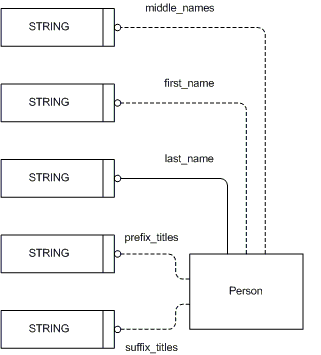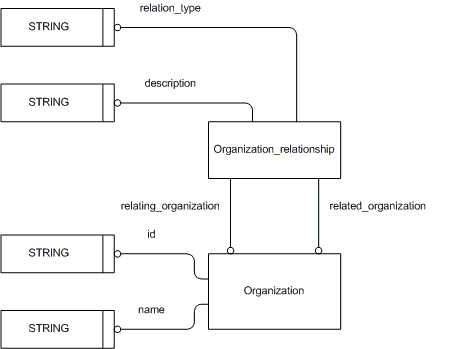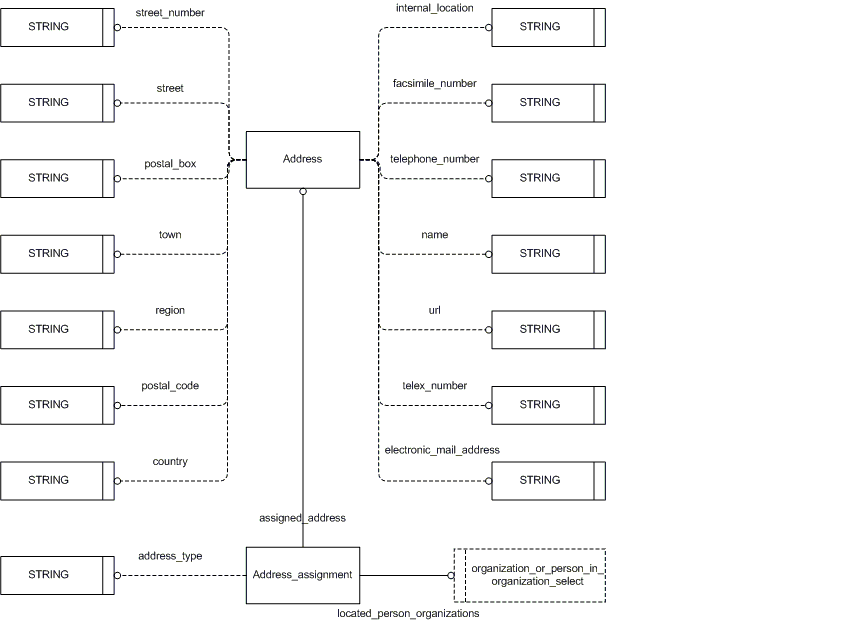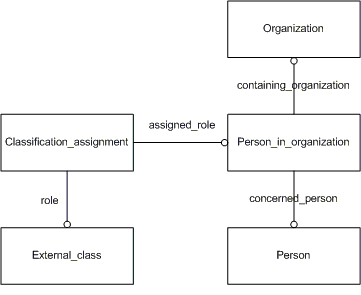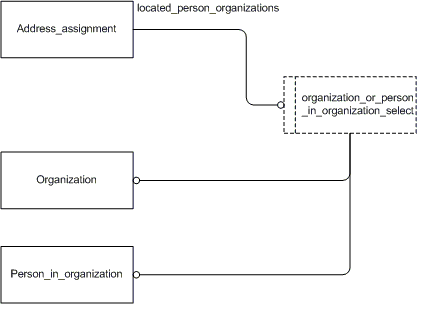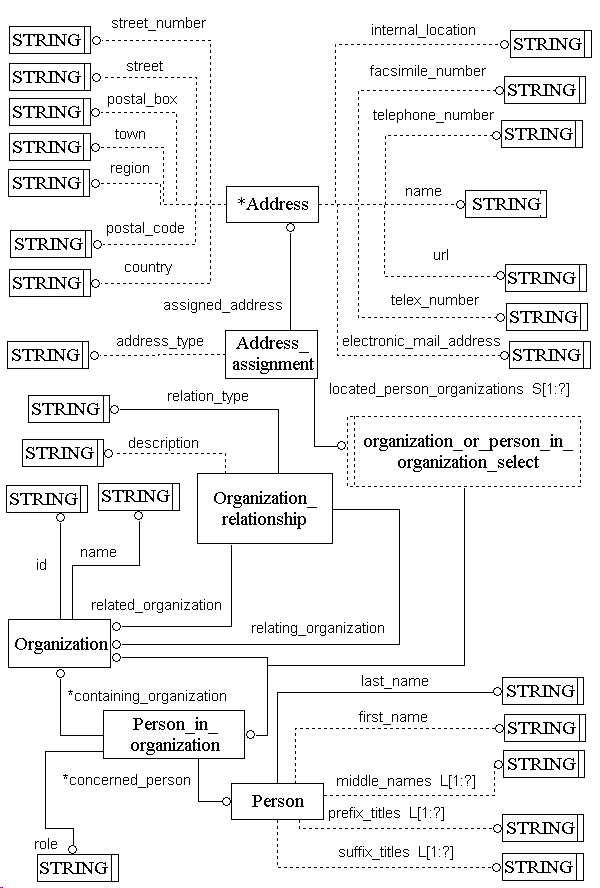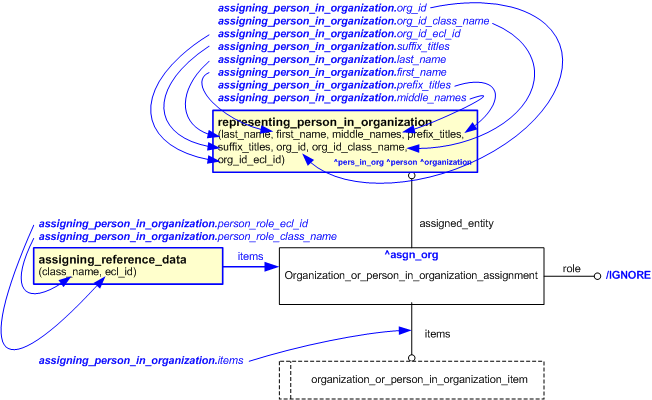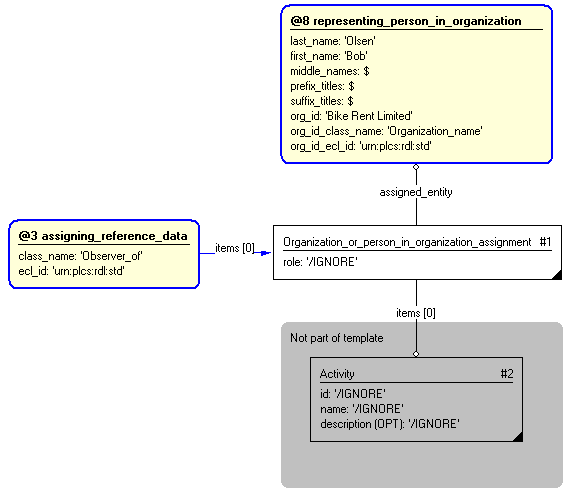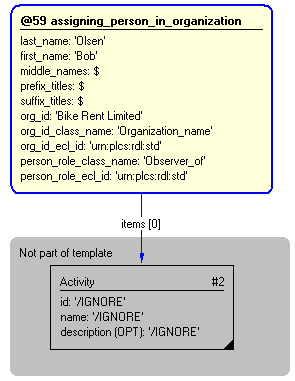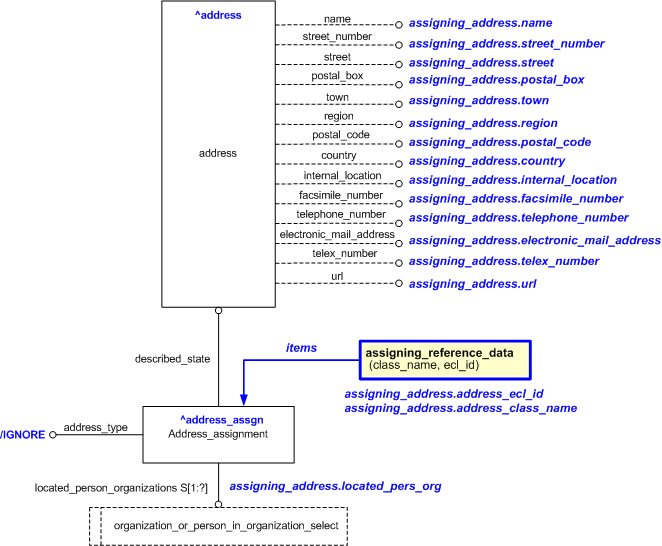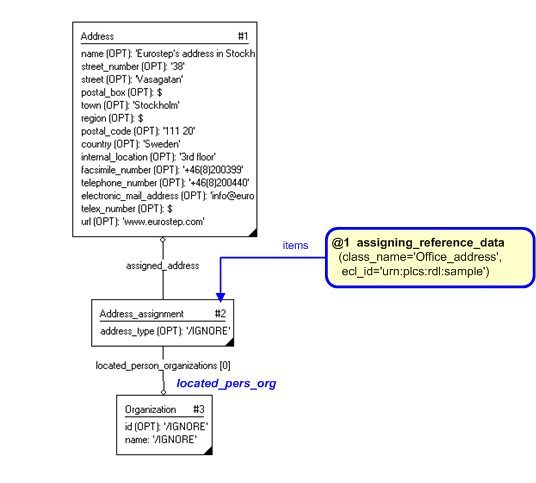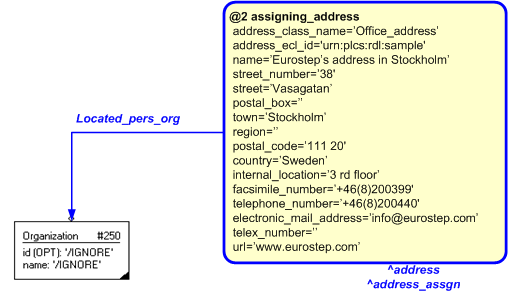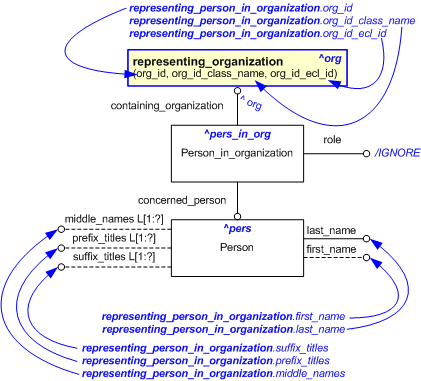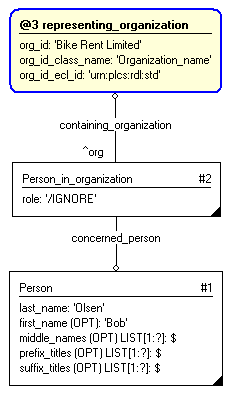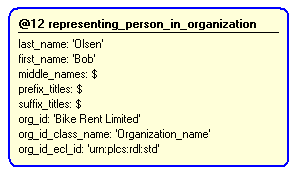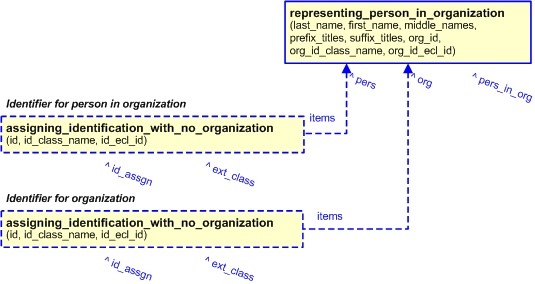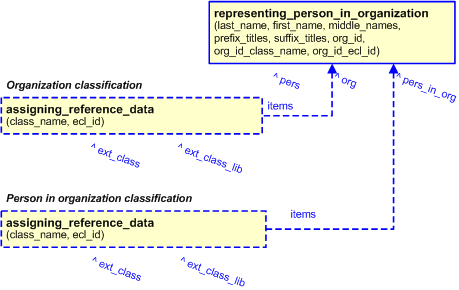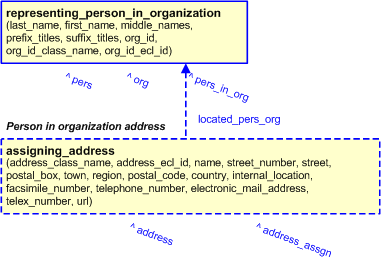| Capability (C016):— representing_person_organization |
Date: 2007/06/22 12:22:11
Revision: 1.20
|
This section provides a business level overview of this capability.
The capability has been designed to to provide a comprehensive representation of a person working as an employee within an
organization to perform a specific role. The most common requirement for this information is expected to be the need to record
who has made a decision or given authority for a course of action.
For flexability, the address component can be applied either to the individual or the organization in which the person is
employed. Complex organisations can be represented as a hierachy of one organization within another.
The name of the role played by the person in the organization is delivered by reference to an external reference library,
agreed by the communicating partners.
This section provides an overview of the information model that supports
this capability.
As a mandatory minimum, a Person is identified by their Last Name, but this limited information is normally extended to include a First Name and, where appropriate,
any middle names. Provision is also made for the inclusion of a prefix title, such as Mr, Mrs, Dr, Ft Lt etc., and any suffix
titles, such as CEng, BSc, RAF etc. Figure 1 provides an illustration of the way a person may be represented.
Figure 1 — Representing a Person
At its simplest, an Organization can be represented just by its name, supplied in the form of a text string. Additionally, for reference purposes, and particularly
for use by IT systems, it is convinient to include some form of organization identity key. Further capability can be added
by recognising that an organization usually exists within a hierarch of organisations and it is then necessary to define these
parent / child relationships to identify fully the authority of the actual organization being represented. Figure 2 illustrates
the way an organization, placed within its organizational hierarchy, may be represented.
Figure 2 — Representing an Organization
An Address is recorded as a sequence of pieces of data that, collectively, provide the information necessary to enable communication
with the target. Figure 3 illustrates the way an address may be recorded. Addresses may be associated either with a person
or the organisation in which the person is located.
Figure 3 — Recording an Address
By associating a person with an organization and identifying the role played by that person in that organization, the person
is identified as an employee. These links are created through the entity Person_in_organization. Figure 4 illustrates how this may be done. Provision is made in the capability for the list of role options to be made available
from an external class library.
Figure 4 — Representing a Person in an Organization
Two options are available when choosing to assign an authority to a target. The simple option is just to identify the organization
and this will be appropriate where there is no requirement to attribute the information to an individual. Where this is a
requirement, however, information about the person must also be selected. Figure 5 illustrates this.
Figure 5 — Selection of an Organization or of a Person in an Organization with a Role
Joining up all the sections above delivers the full capability to define a person, an organization, the role that person fulfils
as an employee in the organization and the assignment of that authority to a target.
Figure 6 — Represention of a Person in an Organization with a Role
The following sections define a set of templates for the capability,
where a template is a specification of a set of entities that need to
be instantiated to represent a given set of information.
This section specifies the template assigning_person_in_organization.
NOTE
An explanation of a template and the associated instantiation path is
provided in the
Template overview
section.
This template describes how to assign a person in the context of an organization to
something.
The EXPRESS-G diagram in
Figure
1
shows the templates and EXPRESS entities that are required
to represent the template
"assigning_person_in_organization".
The text highlighted in blue shows the template parameters.
Figure 1 — An EXPRESS-G representation of the Information model for
assigning_person_in_organization
The graphic for the template to be used in other EXPRESS-G diagrams
is shown in Figure
2
below.
Figure 2 — The graphical representation of assigning_person_in_organization template
The following input parameters are defined for this template:
the last name (surname) of the person doing the approval
The first element of the Person's list of forenames. This parameter is
optional.
The Person's other forenames.
The text that specifies the Person's social or professional standing and appear
before his or her names. This parameter is optional.
The text that specifies the Person's social or professional standing and appear
after his or her names. This parameter is optional.
The identifier or name of the organization.
The name of the class used to classify the identification (
Identification_assignment) of the organization. This provides the role or reason for the identification. For
example CAGE code.
The following classes and their sub-classes can be used:
The identifier of the
External_class_library storing the
definition of the class referenced by the parameter @org_id_class_name class.
The name of the class being used to classify the person assignment (
) This provides
the role for the assignment.
The following classes and their sub-classes can be used:
The identifier of the
External_class_library storing the
definition of the class referenced by the parameter @person_role_class_name class.
The items to which the person is assigned
The following reference parameters are defined for this template:
%^target = $assigning_person_in_organization.asgn_org%
Allow the
Person_in_organization
entity instantiated in this path to be referenced when this template is used.
%^target = $assigning_person_in_organization.pers_in_org%
Allow the
Person
entity instantiated in this path to be referenced when this template is used.
Note: The
Person
entity can be referenced in a template path by:
%^target = $assigning_person_in_organization.person%
where
target
is the parameter to which the
Person
is bound.
Allow the
Organization
entity instantiated in this path to be referenced when this template is used.
Note: The
Organization
entity can be referenced in a template path by:
%^target = $assigning_person_in_organization.organization%
where
target
is the parameter to which the
Organization
is bound.
The instantiation path shown below specifies the entities that are to be
instantiated by the template.
-- Instantiate Organization_or_person_in_organization_assignment entity Organization_or_person_in_organization_assignment-- Bind the Organization_or_person_in_organization_assignment -- to the parameter ^asgn_org. The parameter is a reference parameter -- so the Organization_or_person_in_organization_assignment -- entity can be referred to when this template is used. %^asgn_org =
Organization_or_person_in_organization_assignment%
-- Set the Organization_or_person_in_organization_assignment attribute role to be ignored Organization_or_person_in_organization_assignment.role = '/IGNORE'
-- Assign the Organization_or_person_in_organization_assignment -- to the instances passed into the template through the @items -- input parameter (e.g. an Activity_actual) Organization_or_person_in_organization_assignment.items ->
@items-- Assign reference data to Organization_or_person_in_organization_assignment /
assigning_reference_data(
items=^asgn_org,
class_name=@person_role_class_name,
ecl_id=@person_role_ecl_id)/
-- Instantiate representing_person_in_organization /
representing_person_in_organization(
last_name=@last_name,
first_name=@first_name,
middle_names=@middle_names,
prefix_titles=@prefix_titles,
suffix_titles=@suffix_titles,
org_id=@org_id,
org_id_class_name=@org_id_class_name,
org_id_class_name=@org_id_class_name,
org_id_ecl_id=@org_id_ecl_id)/
%^pers_in_org = $representing_person_in_organization.pers_in_org%
%^person = $representing_person_in_organization.pers%
%^organization = $representing_person_in_organization.org%
-- Assign the Organization_or_person_in_organization_assignment -- to the representing_person_in_organization template Organization_or_person_in_organization_assignment.assigned_entity ->
^pers_in_org
The following entities are instantiated with attributes as specified:
The instance diagram in Figure
3
shows an example of the EXPRESS entities and templates that are instantiated by the template:
(an illustration of the consolidated assigning_person_organization template is shown in
Figure
4 below.)
Figure 3 — Entities instantiated by assigning_person_in_organization template
The instance diagram in
Figure
4
shows the graphic symbol for the template that is to be
used in other instance diagrams. The example template is:
Figure 4 — Instantiation of assigning_person_in_organization template
No common characterizations of the template
assigning_person_in_organization
have been identified. However, the ISO 10303-239 EXPRESS model
may enable other assignments to the entities instantiated by the template.
This section specifies the template assigning_address.
NOTE
An explanation of a template and the associated instantiation path is
provided in the
Template overview
section.
This template describes how to assign an address to something.
The EXPRESS-G diagram in
Figure
1
shows the templates and EXPRESS entities that are required
to represent the template
"assigning_address".
The text highlighted in blue shows the template parameters.
Figure 1 — An EXPRESS-G representation of the information model for assigning_address
The graphic for the template to be used in other EXPRESS-G diagrams
is shown in Figure
2
below.
Figure 2 —
The graphical representation of assigning_address template
The following input parameters are defined for this template:
The name of the class being used to classify the
address.
This provides the type of address,
for example 'office_address'.
The following classes and their sub-classes can be used:
The identifier of the
External_class_library
storing the definition of the class referenced by the parameter @address_class_name.
name (Type='STRING', Optional)
The name or identifier of the address.
Parameter is optional.
The number of a location on a street.
Parameter is optional.
street (Type='STRING', Optional)
The name of a street.
Parameter is optional.
The number of a postal box.
Parameter is optional.
town (Type='STRING', Optional)
The name of a town.
Parameter is optional.
region (Type='STRING', Optional)
The name or identifier of a region.
Parameter is optional.
The code that is used by the country's postal service.
Parameter is optional.
The name of a country.
Parameter is optional.
An organization-defined address for internal mail delivery.
Parameter is optional.
The number to which facsimiles may be sent.
Parameter is optional.
The number at which telephone calls may be received.
Parameter is optional.
The electronic address to which electronic mail may be sent.
Parameter is optional.
The number where telex messages may be received.
Parameter is optional.
url (Type='STRING', Optional)
The text that specifies the Uniform Resource Locator associated with the address.
Parameter is optional.
The items to which the address is assigned
The following reference parameters are defined for this template:
Allow the
Address
entity instantiated in this path to be referenced when this template is used.
Note: The
Address
entity can be referenced in a template path by:
%^target = $assigning_address.address%
where
target
is the parameter to which the
Address
is bound.
Allow the
Address_assignment
entity instantiated in this path to be referenced when this template is used.
%^target = $assigning_address.address_assgn%
The instantiation path shown below specifies the entities that are to be
instantiated by the template.
The following entities are instantiated with attributes as specified:
The instance diagram in Figure
3
shows an example of the EXPRESS entities and templates that are instantiated by the template:
/assigning_address(address_class_name='Office_address', address_ecl_id='urn:plcs:rdl:sample', name='Eurostep's address in Stockholm', street_number='38', street='Vasagatan', postal_box='', town='Stockholm', region='', postal_code='111 20', country='Sweden', internal_location='3rd floor', facsimile_number='+46(8)200399', telephone_number='+46(8)200440', electronic_mail_address='info@eurostep.com', telex_number='', url='www.eurostep.com', located_pers_org='#250')/
(an illustration of the consolidated assigning_address template is shown in
Figure
4 below.)
Figure 3 — Entities instantiated by assigning_address template
The instance diagram in
Figure
4
shows the graphic symbol for the template that is to be
used in other instance diagrams. The example template is:
/assigning_address(address_class_name='Office_address', address_ecl_id='urn:plcs:rdl:sample', name='Eurostep's address in Stockholm', street_number='38', street='Vasagatan', postal_box='', town='Stockholm', region='', postal_code='111 20', country='Sweden', internal_location='3rd floor', facsimile_number='+46(8)200399', telephone_number='+46(8)200440', electronic_mail_address='info@eurostep.com', telex_number='', url='www.eurostep.com', located_pers_org='#250')/
Figure 4 — Instantiation of assigning_address template
The following section details how the
assigning_address
template can be optionally characterized by assigning
other constructs to it. These are characterizations commonly
applied to the template. The ISO 10303-239 EXPRESS model may enable
other assignments to the entities instantiated by the template.
The following characterizations may apply:
Characterization Assigning dated effectivity
NOTE this characterization is optional.
The address of a person or organization may change over time.
This is represented by associating a dated effectivity with the
assignment of an address where the effectivity represents the period in
which the person or organization was at the address.
The dated effectivity is represented by using the template
assigning_dated_effectivity
to assign a start and end-bound date to an
Address_assignment.
This section specifies the template representing_person_in_organization.
NOTE
An explanation of a template and the associated instantiation path is
provided in the
Template overview
section.
This template describes the representation of a person to an organization
independent of other entities in order to be referenced from other templates.
The EXPRESS-G diagram in
Figure
1
shows the templates and EXPRESS entities that are required
to represent the template
"representing_person_in_organization".
The text highlighted in blue shows the template parameters.
Figure 1 — An EXPRESS-G representation of the Information model for representing_person_organization
The graphic for the template to be used in other EXPRESS-G diagrams
is shown in Figure
2
below.
Figure 2 — The graphical representation of the representing_person_organization template
The following input parameters are defined for this template:
The last name (surname) of the person.
first_name (Default=/NULL,Type='STRING', Optional)
The first element of the Person's list of forenames. This parameter is optional.
The Person's other forenames.
The text that specifies the Person's social or professional standing
and appear before his or her names. This parameter is optional.
The text that specifies the Person's social or professional standing
and appear after his or her names. This parameter is optional.
The identifier or name of the organization.
The following classes and their sub-classes can be used:
The identifier of the
External_class_library
storing the definition of the class referenced by the parameter @org_id_class_name class.
The following reference parameters are defined for this template:
Allow the
Person
entity instantiated in this path to be referenced when this template is used.
Note: The
Person
entity can be referenced in a template path by:
%^target = $representing_person_in_organization.pers%
where
target
is the parameter to which the
Person
is bound.
Allow the
Organization
entity instantiated in this path to be referenced when this template is used.
Note: The
Organization
entity can be referenced in a template path by:
%^target = $representing_person_in_organization.org%
where
target
is the parameter to which the
Organization
is bound.
Allow the
Person_in_organization
entity instantiated in this path to be referenced when this template is used.
%^target = $representing_person_in_organization.pers_in_org%
The following parameter combinations specify a uniqueness constraint:
Unique constraint: Unique person in organization
The instantiation path shown below specifies the entities that are to be
instantiated by the template.
The following entities are instantiated with attributes as specified:
The instance diagram in Figure
3
shows an example of the EXPRESS entities and templates that are instantiated by the template:
@12 /representing_person_in_organization(last_name='Olsen', first_name='Bob', middle_names='$', prefix_titles='$', suffix_titles='$', org_id='Bike Rent Limited', org_id_class_name='Organization_name', org_id_ecl_id='urn:plcs:rdl:std')/
(an illustration of the consolidated representing_person_in_organization template is shown in
Figure
4 below.)
Note that the template
representing_organization is used in the diagram:
@3 /representing_organization(id='Bike Hire Limited', id_class_name='Organization_name', id_ecl_id='urn:plcs:rdl:std')/
Figure 3 — Entities instantiated by representing_person_in_organization template
The instance diagram in
Figure
4
shows the graphic symbol for the template that is to be
used in other instance diagrams. The example template is:
@12 /representing_person_in_organization(last_name='Olsen', first_name='Bob', middle_names='$', prefix_titles='$', suffix_titles='$', org_id='Bike Rent Limited', org_id_class_name='Organization_name', org_id_ecl_id='urn:plcs:rdl:std')/
Figure 4 — Instantiation of representing_person_in_organization template
The following section details how the
representing_person_in_organization
template can be optionally characterized by assigning
other constructs to it. These are characterizations commonly
applied to the template. The ISO 10303-239 EXPRESS model may enable
other assignments to the entities instantiated by the template.
The following characterizations may apply:
Characterization Assigning identification
NOTE this characterization is optional.
Characterization Assigning classifications
NOTE this characterization is optional.
Characterization Assigning address
NOTE this characterization is optional.
